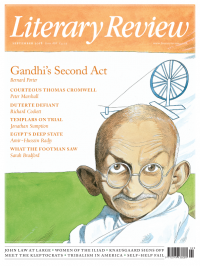Nicholas Vincent
The Devil Wears Ermine
The Restless Kings: Henry II, His Sons and the Wars for the Plantagenet Crown
By Nick Barratt
Faber & Faber 320pp £20
King of the North Wind: The Life of Henry II in Five Acts
By Claudia Gold
William Collins 397pp £25
Imagine a situation in which, for thirty-five years, the English experienced unprecedented levels of engagement with Continental Europe. In consequence, they came to enjoy greater prosperity than they had known at any time since the fall of Rome. Then followed a period of uncertainty. Failures of government led to a break with England’s allies and a sudden withdrawal of the English from the Continent. An economic downturn ensued, accompanied by rising xenophobia, leading almost immediately to the greatest constitutional crisis in English history.
If the circumstances outlined here seem familiar, then they just as easily apply to the later 12th century as to more recent events. Between 1154 and 1189, Henry II of England assembled the greatest collection of lands of any western king since Charlemagne. Born the son of a mere count of Anjou, via his mother (the daughter of King Henry I of England) and his wife (Eleanor, heiress to the duchy of Aquitaine), Henry came not only to wear a royal crown but also to outmanoeuvre all his European rivals. Through a combination of military and political skill, his lieutenants came to rule in Brittany, Dublin and, rather less securely, Edinburgh. Paris itself became a French frontier town, walled and fortified against the threat of English conquest. By the 1180s, Henry’s children had married into the ruling dynasties of Germany, France, Spain and Sicily. Such was his power that even the keys of the city of Jerusalem were offered to him as a token of his greatness.
Henry’s achievements were all the more remarkable given that, in the eyes of many, his origins were satanic. According to family legend, itself keenly promoted by Henry and his sons, his was the ‘Devil’s Brood’: descended from the she-demon Melusine, half-woman, half-serpent. ‘From the Devil he came, and

Sign Up to our newsletter
Receive free articles, highlights from the archive, news, details of prizes, and much more.@Lit_Review
Follow Literary Review on Twitter
Twitter Feed
It wasn’t until 1825 that Pepys’s diary became available for the first time. How it was eventually decrypted and published is a story of subterfuge and duplicity.
Kate Loveman tells the tale.
Kate Loveman - Publishing Pepys
Kate Loveman: Publishing Pepys
literaryreview.co.uk
Arthur Christopher Benson was a pillar of the Edwardian establishment. He was supremely well connected. As his newly published diaries reveal, he was also riotously indiscreet.
Piers Brendon compares Benson’s journals to others from the 20th century.
Piers Brendon - Land of Dopes & Tories
Piers Brendon: Land of Dopes & Tories - The Benson Diaries: Selections from the Diary of Arthur Christopher Benson by Eamon Duffy & Ronald Hyam (edd)
literaryreview.co.uk
Of the siblings Gwen and Augustus John, it is Augustus who has commanded most attention from collectors and connoisseurs.
Was he really the finer artist, asks Tanya Harrod, or is it time Gwen emerged from her brother’s shadow?
Tanya Harrod - Cut from the Same Canvas
Tanya Harrod: Cut from the Same Canvas - Artists, Siblings, Visionaries: The Lives and Loves of Gwen and Augustus John by Judith Mackrell
literaryreview.co.uk